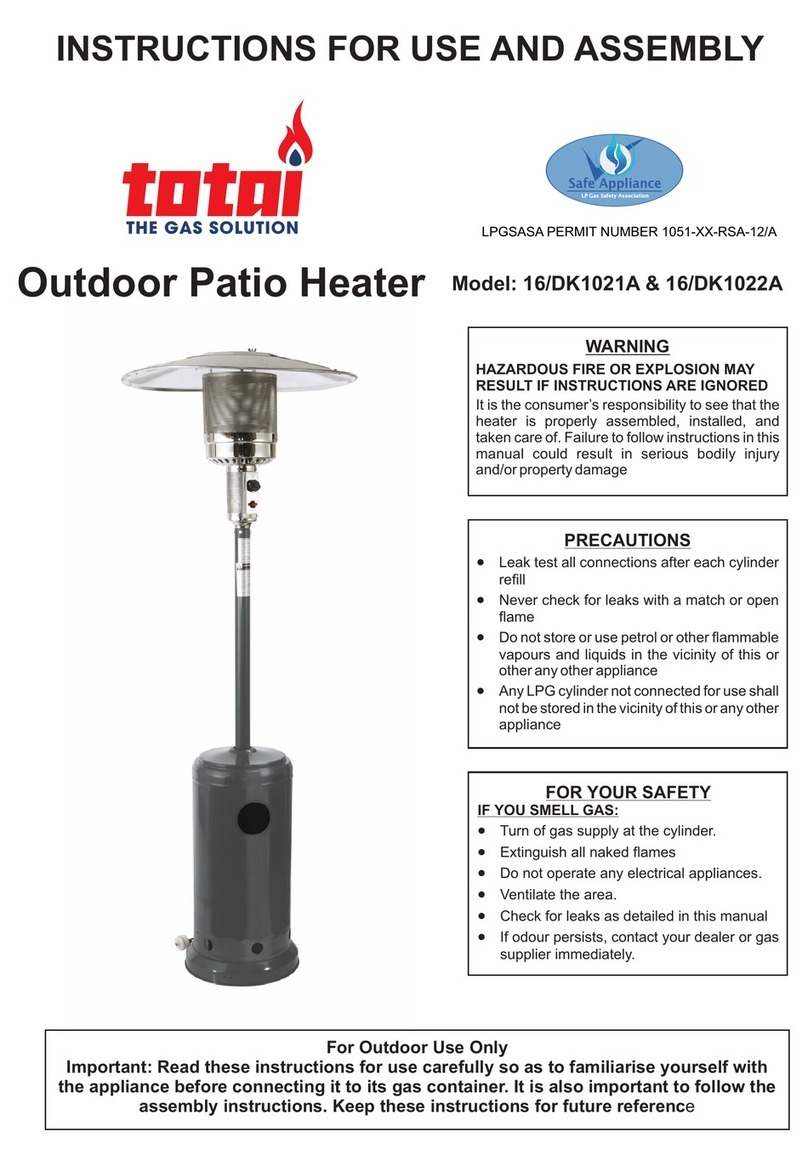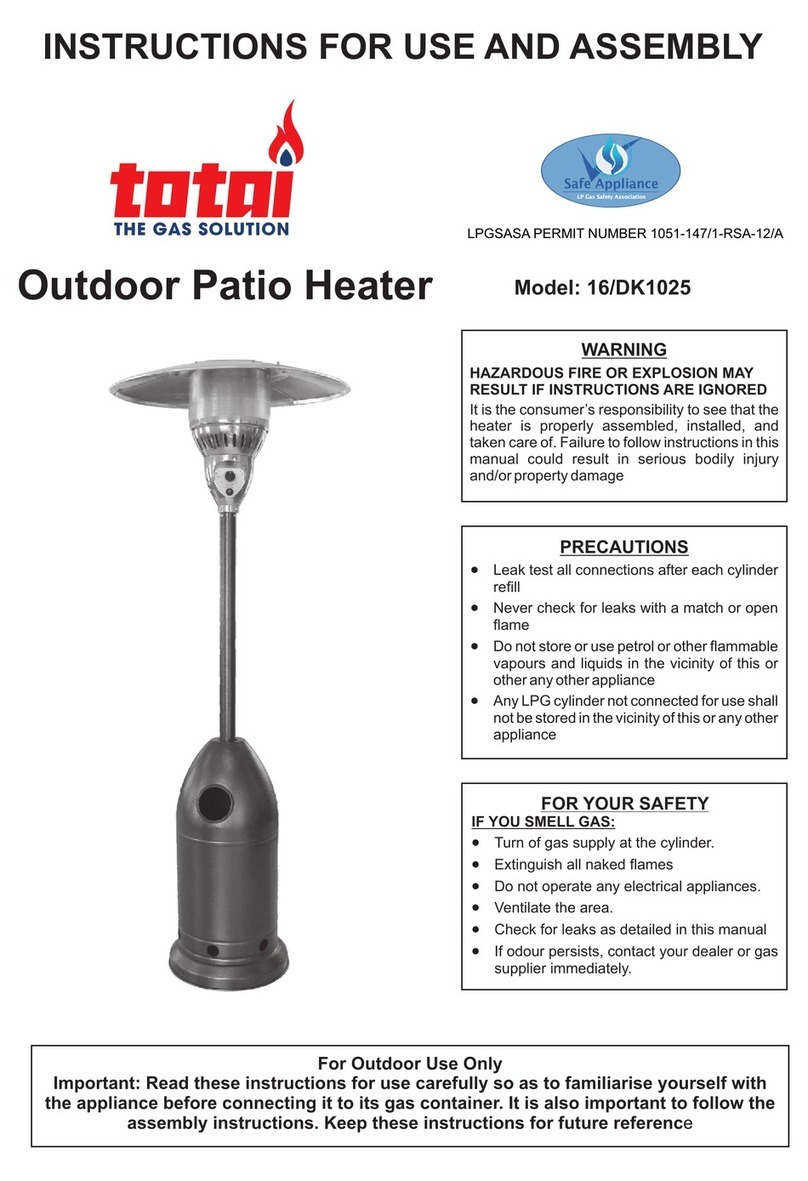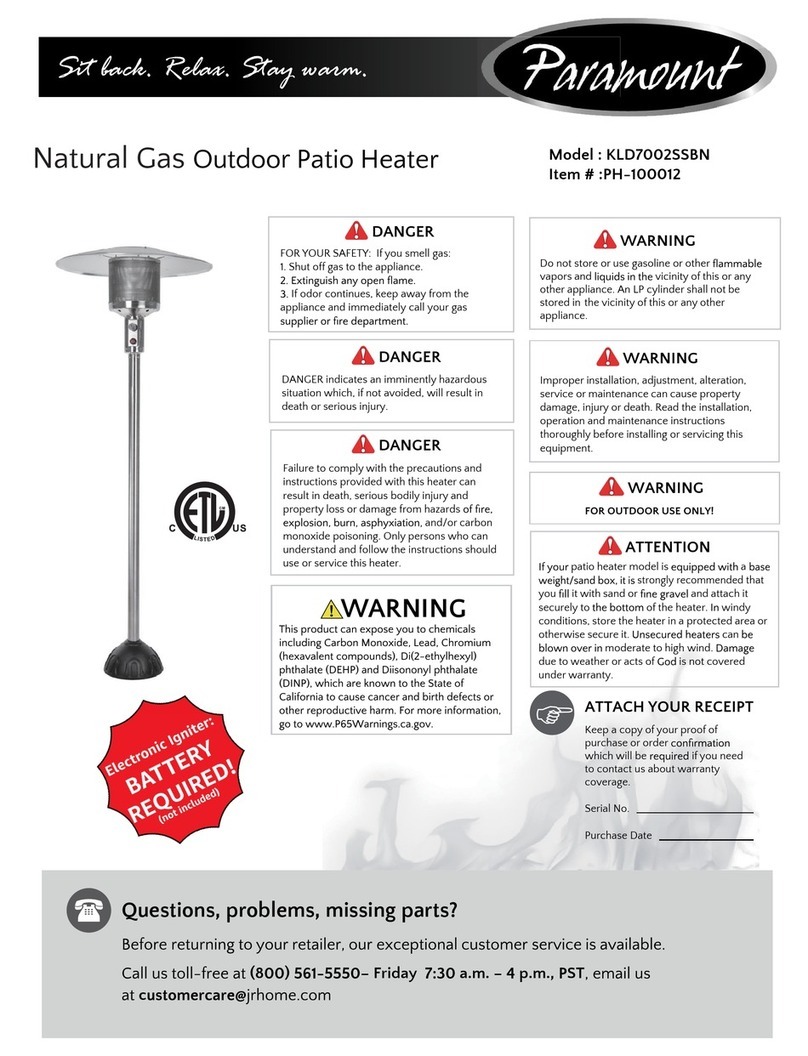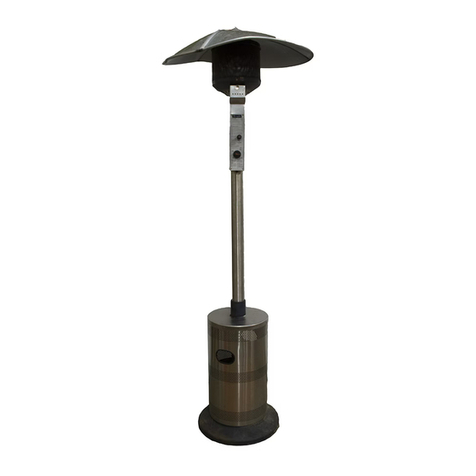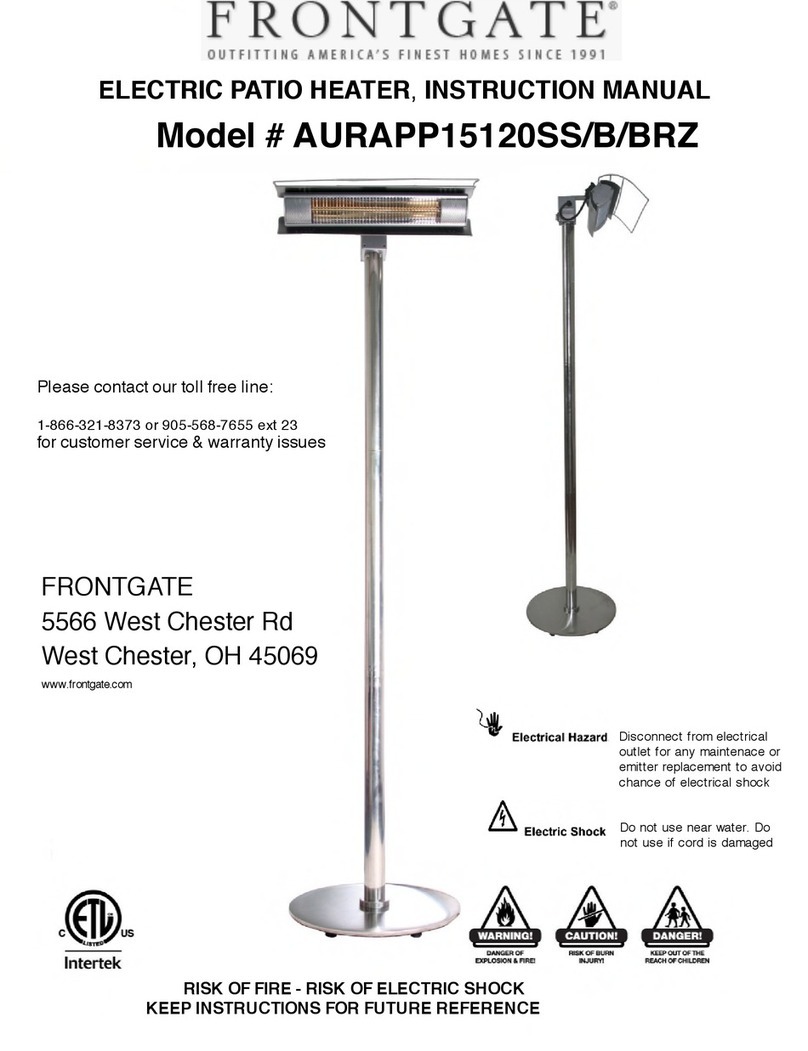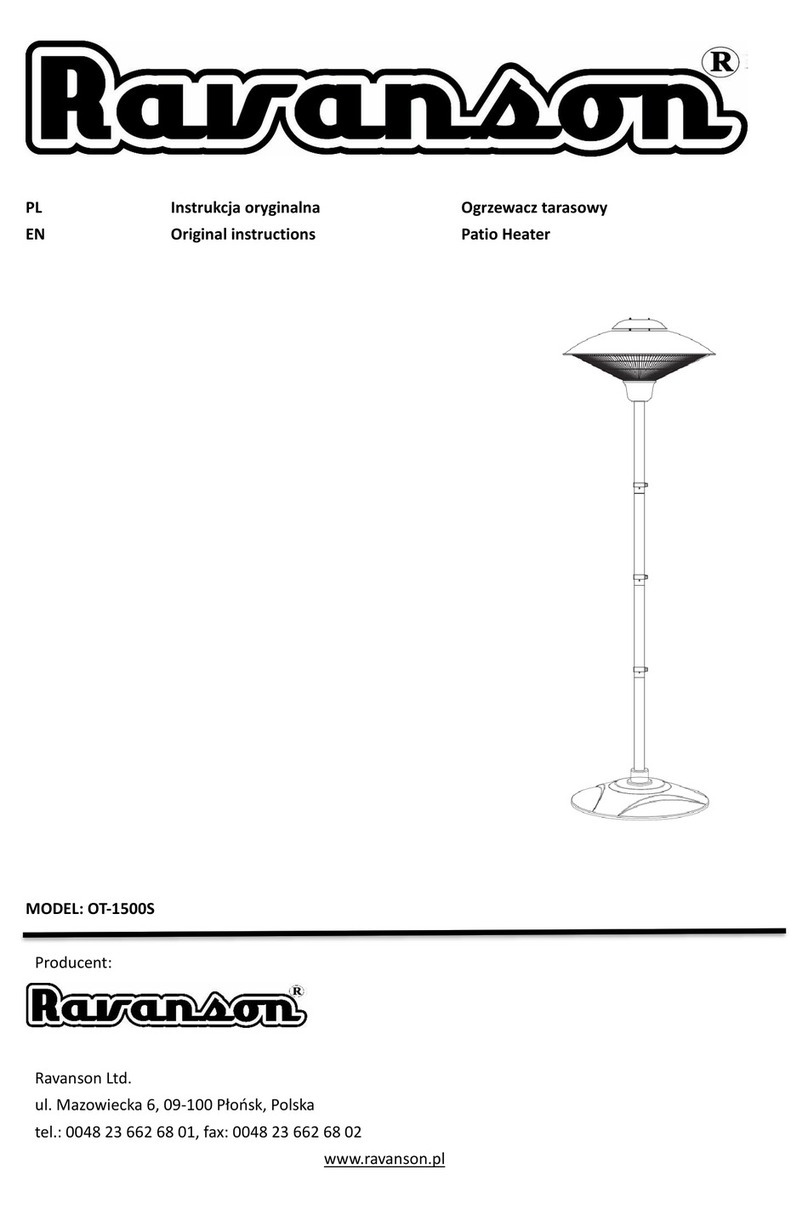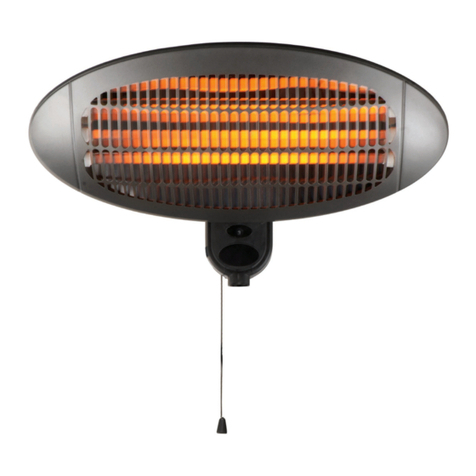Totai 16/DK1027 User manual

This appliance complies with SANS 1539;2017
Safe Appliance
LP Gas Safety Association
Outdoor Patio Heater
Instructions for use and assembly
Model: 16/DK1027
PRECAUTIONS
·Leak test all connections after each cylinder
refill
·Never check for leaks with a match or open
flame
·Do not store or use petrol or other flammable
vapours and liquids in the vicinity of this or
other any other appliance
·Any LPG cylinder not connected for use shall
not be stored in the vicinity of this or any other
appliance
WARNING
HAZARDOUS FIRE OR EXPLOSION MAY
RESULT IF INSTRUCTIONS ARE
IGNORED
It is the consumer’s responsibility to see that the
heater is properly assembled, installed, and
taken care of. Failure to follow instructions in this
manual could result in serious bodily injury
FOR YOUR SAFETY
IF YOU SMELL GAS:
·Turn of gas supply at the cylinder.
·Extinguish all naked flames
·Do not operate any electrical appliances.
·Ventilate the area.
·Check for leaks as detailed in this manual
·If odour persists, contact your dealer or gas
supplier immediately.
For Outdoor Use Only
Important: Read these instructions for use carefully and retain them for future
reference. It is also important to follow the assembly instructions.

PLEASE READ THE FOLLOWING SAFETY GUIDELINES BEFORE OPERATION
ŸDo not use the patio heater indoors, as it may cause personal injury or property damage.
ŸThis outdoor heater in not intended to be installed on recreational vehicles and/or boats.
ŸInstallation and services should only be a done qualified service person.
ŸImproper installation, adjustment, alteration can cause personal injury or property damage.
ŸDo not attempt to alter the unit in any manner as to do so may make it unsafe
ŸNever replace or substitute the regulator with any regulator other than the factory recommended replacement.
ŸDo not store or use petrol or other flammable liquids or vapours with, in, or near the heater.
ŸThe complete gas system and all connections should be inspected for leaks before use, and at least annually by a
qualified service technician.
ŸAll leak tests should be done with a soapy water solution. If there is a leak then bubbles will form at that point.
Never use an open flame to check for gas leaks.
ŸDo not use the heater until all connections have been leak tested.
ŸIf you smell gas, turn off the gas supply at the cylinder and check all connections for leaks using a soapy water
solution. Tighten the leaking connection and then recheck again with a soapy water solution. If you cannot find the
source of the leak, call a qualified service technician and do not use the appliance until it has been declared safe to
do so.
ŸDo not move or transport the heater and the table or bench on which it stands whilst it is operating.
ŸDo not touch or move the heater after it has been turned off until it has cooled down.
ŸDo not paint the radiant screen, control panel or top canopy reflector.
ŸThe control compartment, burner and circulation air passageways must be kept clean.
ŸFrequent cleaning may be necessary as required.
·Check the heater immediately if any of the following occurs:
- The heater does not reach temperature.
- The burner makes popping noises during operation (a slight noise is normal when the heater is extinguished).
- A smell of gas in conjunction with yellow tipping o flames.
ŸAny guard or other protective device removed for servicing must be replaced before using the heater.
ŸAdults and children should stay away from high temperatures areas of the heater to avoid burns or clothing igniting.
ŸChildren should be carefully supervised when near the heater
ŸAlways change the cylinder in well ventilated areas and away from any sources of ignition e.g. open flames.
ŸCheck that the regulator seal is in place and in good condition whenever the cylinder is changed.
ŸAlways close the cylinder control valve when the heater is not in use.
ŸIn the event of a gas leakage do not use the heater. Call a qualified service technician to examine the heater before
using the heater.
ŸCheck the condition of the flexible gas hose at least once per year for sign of cracking, bulging, splitting or other
signs of deterioration. Replace if necessary.
ŸIn the event of a burn-back, where the flame burns back to the jet, immediately turn off the gas supply at the control
valve on the panel. After ensuring the flame is extinguished, re-light the appliance in the normal manner. Should the
appliance again burn back, close the control valve and call a service technician. Do not use the appliance again
until the service technician has declared that it is safe to do so.
- 2 -

- 3 -
TABLE OF CONTENTS
Caution ………………………………………………………. 1
Heater Stand and Location ………………………………… 2
Gas Requirements ………………………………………….. 2
Leakage Test ………………………………………………… 2
Operation and Storage ……………………………………... 3
Cleaning and Care ………………………………………….. 4
Parts and Specifications ..………………………………….. 4
Assembly Parts and Procedures ………………………….. 6
Problems Check List ………………………………………... 11

- 4 -
CAUTION
PLEASE READ CAREFULLY THE FOLLOWING SAFETY GUIDELINES BEFORE OPERATION.
Do not use the patio heater for indoors, as it may cause personal injury or property damage.
This outdoor heater is not intended to be installed on recreational vehicles and/or boats.
Installation and repair should be done by a qualified service person.
Improper installation, adjustment, alteration can cause personal injury or property damage.
Do not attempt to alter the unit in any manner.
Never replace or substitute the regulator with any regulator other than the factory-suggested replacement.
Do not store or use gasoline or other flammable vapors or liquids in the heater unit.
The whole gas system, hose, regulator, pilot or burner should be inspected for leaks or damage before
use, and at least annually by a qualified service person.
All leak tests should be done with a soap solution. Never use an open flame to check for leaks.
Do not use the heater until all connections have been leak tested.
Do not transport heater while it’s operating.
Do not move the heater after it has been turned off until the temperature has cooled down.
Keep the ventilation opening of the cylinder enclosure free and clear of debris.
Do not paint the radiant screen, control panel or top canopy reflector.
Control compartment, burner and circulation air passageways of the heater must be kept clean.
Frequent cleaning may be required as necessary.
The LP tank should be turned off when the heater is not in use.
Check the heater immediately if any of the following occurs:
- The heater does not reach temperature.
- The burner makes popping noise during use (a slight noise is normal when the burner is extinguished).
- Smell of gas in conjunction with extreme yellow tipping of the burner flames.
The LP regulator/hose assembly must be located out of pathways where people may trip over it or in
area where the hose will not be subject to accidental damage.
Any guard or other protective device removed for servicing the heater must be replaced before operating the heater.
Adults and children should stay away from high temperature surface to avoid burns or clothing ignition.
Children should be carefully supervised when they are in the area of the heater.
Cl
To change the gas cylinder in a amply ventilated area, away from any ignition
source (candle, cigarettes, other flame producing appliances, ...);
To check that the regulator seal is correctly fitted and able to fulfill its function
showed as photo right;
To not obstruct the ventilation holes of the cylinder housing;
To close the gas supply at the valve of the gas cylinder or the regulator after use;
In the event of gas leakage, the appliance shall not be used or if alight, the gas supply
shall be shut off and the appliance shall be investigated and rectified before it is used again;
To check the hose at least once per month, each time the cylinder is changed,or each time before long time no use.
If it shows signs of cracking, splitting or other deterioration it shall be exchanged for new hose of the same length and of the
equivalent quality;
The use of this appliance in enclosed areas can be dangerous and is PROHIBITED;
Read the instructions before using this appliance. The appliance must be installed in accordance with the instructions and
local regulations.
For connection of hose and regulator,and connection of regulator and hose, please refer to photo showed above.
othing or other flammable materials should not be hung on the heater or placed on or near the heater.
T
Regulator connection: tighten connection and perform another leak test. If bubbles continue appearing
should be returned to hose’s place of purchase. If leak is at Regulator/Cylinder Valve connection: disconnect,
reconnect, and perform another leak check. If you continue to see bubbles after several attempts, cylinder
valve is defective and should be returned to cylinder’s place of purchase.
urn off the gas valve immediately if smell of gas is detected. Turn Cylinder Valve OFF.If leak is at Hose/
Hose/ Regulator connection and
Regulator / Cylinder connection
seal hose
regulater
cylinder

C E I L I N G
W A L L
100 cm
100 cm
ŸUse a 9 kg LPG cylinder only.
ŸThe hose must comply with the requirements of SANS 1156-2 or BS 2312.
ŸA dented, rusted or damaged LPG cylinder may be hazardous and should not be used.
ŸNever use a cylinder with a damaged valve connection.
ŸThe cylinder valve must have a horizomtal outlet with a G5/8 left hand thread to suit the regulator.
ŸNever connect the cylinder directly to the heater. A regulator must always be used.
ŸThe regulator must comply with the requirements of SANS 1237 and must have a G3/8 right hand threaded
connector.
ŸMake sure the rubber seal on the regulator connector is in place and in good condition before connecting
the regulator to the cylinder valve.
ŸThe heater is for outdoor use only. Always ensure that adequate fresh
air ventilation is provided.
ŸAlways maintain proper clearance to combustible materials, i.e. top
100 cm and sides 100 cm minimum.
ŸThe heater must be placed on firm level ground
ŸNever operate heater in areas where petrol or other flammable liquids
or vapours are stored.
HEATER STAND AND LOCATION
GAS REQUIREMENTS
LEAKAGE TEST
ŸGas connections on the heater are leak tested at the factory prior to shipment. A complete gas tightness
check must be performed at the installation site due to possible mishandling in shipment or excessive
pressure being applied to the heater.
ŸMake a soap solution of one part liquid detergent and one part water. The soap solution can be applied with
a spray bottle, brush or rag. Soap bubbles will appear in case of a leak.
ŸThe heater must be checked with a full cylinder.
ŸMake sure the safety control valve on the appliance is in the OFF position.
ŸConnect the regulator with the gas hose secured to the regulator outlet and to the gas inlet on the appliance
to the cylinder valve.
ŸTurn the gas supply ON by opening the cylinder valve.
ŸCheck for leaks by brushing or spraying the soapy solution over the connection joints
ŸIn case of a leak, turn off the gas supply by closing the cylinder valve. Tighten any leaking connections, then
turn the gas supply on and re-check.
ŸNever leak test while smoking.
ŸIf unable to prevent a leak, call a service technician to examine the appliance and do not use it until the
technician has declared it safe to do so
- 5 -

OPERATION AND STORAGE
TO TURN ON THE HEATER
1. Open the cylinder valve after checking that the connections are all tight and that there
are no gas leaks
2. Press in and then turn the appliance control valve knob in an anti clockwise direction to
the Pilot position
3. With the appliance control valve in the Pilot position continue to press the control valve
knob in and whilst doing so press the ignitor button several times until the Pilot burner
ignites. Once the pilot burner has ignited release the control knob
Note:
If a new cylinder has been fitted it may take a minute for the air in the hose to be cleared
before the pilot burner ignites.
If the pilot burner does not ignite repeat Step 3
4. After the Pilot Burner ignites turn the appliance control valve to the full position and
leave it at that setting for 5 minutes before turning the knob to the desired heat setting
TO TURN OFF THE HEATER
1. Press and turn the appliance control knob to the Off position
2. Close the cylinder valve
1. Always close the cylinder valve when the heater is not in use, or if the heater
malfunctions when in use,or if there is a gas leak.
2. Store the cylinder in cool dry well ventilated place away from any other flammable
materials
3. Protect the heater from damage by covering it when not in use.
Off- Shut down position
Hi - Max temperature setting
Lo - Min temperature setting
Variable control knob
Pointer
LOW
HIGH
T
O
L
I
P
OFF
I
G
N
I
T
E
P
u
s
h
t
o
t
u
r
n
- 6 -

- 7 -
•Wipe off powder coated surfaces with soft, moist rag. Do not clean heater with cleaners that
are combustible or corrosive.
•Remove debris from the burner to keep it clean and safe for use.
•Cover the burner unit with the optional protective cover when the heater is not in use.
PARTS AND SPECIFICATIONS
1360 mm
880 mm
370 mm
460 mm
Flame screen guard
Burner assembly
Base of control housing
Tank housing
Base
CLEANING AND CARE

Wrench
Qty. 1
FF
Philips
screwdriver
Qty. 1
EE
DD
M6 Dome Nut
Qty. 1
CC
Screw M5 X 8
Qty. 8
BB
Bolt M8 X 15
Qty. 2
AA M8
Flange
nut
Qty. 2
Burner assembly
NOITPIRCSED TRAP QUANTITY
A
Flame screen guard
1
B 1
Cylinder Housing
C 1
D
Base
E
Wheel
1
1
ŸPhilips screwdriver with medium blade
ŸSpray bottle of soap solution for leakage test
- 8 -
ASSEMBLY PARTS
Tools needed:
Parts List:
A
B
C
D
E

D
AA
EBB
1
- 9 -
1. Use 2 pcs M8x15mm bolts and M 8
nuts to connect bracket with wheel to the
base
2. Use 4 pcs M5x8mm screws nuts to
join the cylinder housing to the base
ASSEMBLY PROCEDURES
C
CC
AA
BB
x 2
M8 x 15 mm Bolts
M8 Flange Nut
x 2
FF Wrench x 1
Hardware Used
2
CC
EE
x 4
x 1
Philips
screwdriver
Screw M5 X 8
Hardware Used

4
A
DD
3
B
CC
-10-
3. Use 4 pcs M5x8mm screw to join
the burner head and cylinder housing
body
4. Use the M6 Dome Nut to connect
the two half safety guards to the
burner head
Hardware Used
CC
EE
x 4
x 1
Philips
screwdriver
Screw M5 X 8
Hardware Used
DD x 1
M6 Dome Nut

5
5.1 Open the door of the cylinder cabinet.
5.2 Attach the hose and regulator assembly to the
gas inlet located inside the cylinder cabinet and
hand tighten, then use a spanner to turn the nut a
further half turn.
5.3. Place the cylinder inside the cylinder cabinet
that turn it so that the cylinder valve is facing the
opening
5.4 Attach the regulator to the gas cylinder valve
and hand tighten. Do not use a spanner on this
connection
Ensure the hose does not contact any high
temperature surfaces or it may melt and
cause a gas leak which could result in a
fire
-11 -
To engage and tighten the
Re g u l a t o r, t u r n t h e
h a n d w h e e l in the
direction of the arrow
To close the cylinder
valve turn the control
knob fully in the
direction of the arrow
l
o
C
s
o
e
T
SAFE CONNECTING INSTRUCTIONS
·Before connecting the LPG regulator to the gas cylinder
ensure that the rubber seal on the end of the regulator is in
place and is in good condition.
·The cylinder valve thread is a left hand thread and the
regulator handwheel must be turned in an anti
clockwise direction (when facing the cylinder valve
thread opening) to engage the regulator thread
correctly into the cylinder valve.
·Always make sure that the regulator is fully engaged with
the cylinder valve threads and that the handwheel is tight.
Hand tighten only. Do not use excessive force.
·When connecting the cylinder always check for leaks by
opening the cylinder valve and then apply a soapy water
solution to the joint between the cylinder valve and the
regulator.
·If you find a leak, close the cylinder valve and contact an
authorised LP gas dealer
·When using the heater do not fully open the cylinder valve.
Only open it 1½ turns to prevent the possible jamming of
the cylinder valve in its open position.
· NEVER UNSCREW THE REGULATOR FROM
THE CYLINDER VALVE WHILST THE CYLINDER
VALVE IS OPEN OR IF THE HEATER IS ALIGHT
REGULATOR CONNECTION

Repairs to the patio heater may only be carried out by a qualified technician
PROBLEM
SOLUTION
Gas valve may be OFF
Turn the
gas valve ON
LPG cylinder empty Refill
LPG cylinder
Orifice blocked
Clean or replace Orifice
Air in supply system Purge air from lines
Pilot will not light
Loose connection
Check all fittings
Debris around pilot Clean dirty area
Loose connection
Tighten connection
.
Thermocouple bad
Replace Thermocouple
Gas leak in line Check connections
Pilot will not stay on
Lack of gas pressure LPG cylinder is near empty
Gas pressure is low LPG cylinder is near empty
Orifice blocked
Remove, clean and replace
Control knob not ON Turn knob to ON .
Thermocouple bad
Replace Thermocouple
Burner will not light
Pilot light assembly bent
or not in correct location .
Place pilot light in correct positi on
and retry
PROBABLE CAUSE
- 12 -
Distributed by: D.K.Gas Appliances. PO Box 34191 Erasmia 0023
TAMPERING:
Under no circumstances are you allowed to tamper with the jet sizes or modify anything on
the appliance. Not only is it dangerous , it will also nullify your warranty
NOTE:
GAS-PRESSURE REGULATOR—This appliance is designed to operate on a gas pressure of
2,8 kPa. A suitable regulator that complies with the requirements of SANS 1237 must be used
with this appliance
TECHNICAL SPECIFICATIONS
Name
Specification
Model number
16/DK1027
Heat Output
11,0 kw
Gas Type
LPG
Jet sizes
Main burner 1,51 mm Pilot burner 0,22 mm
Operating Pressure
2,8 kPa
Gas consumtion (max.)
750 g/h
PROBLEMS CHECK LIST
Table of contents
Other Totai Patio Heater manuals
Popular Patio Heater manuals by other brands
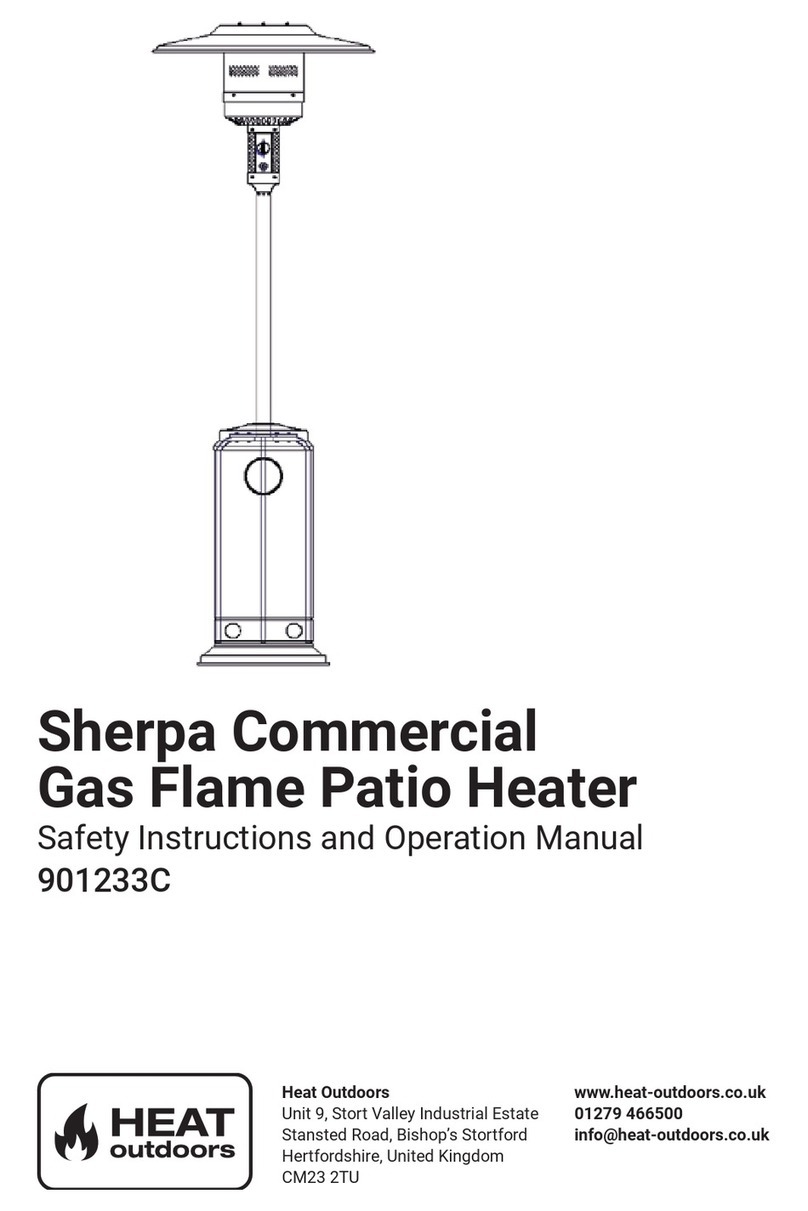
Sherpa
Sherpa 901233C Safety instructions and operation manual

Romus
Romus 93448 Manual instruction
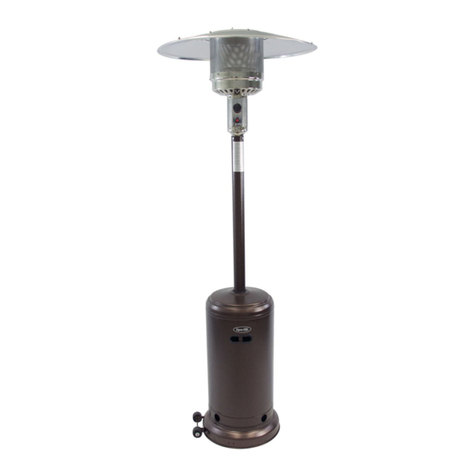
Dyna-Glo
Dyna-Glo DGPH101BR owner's manual

Endless Summer
Endless Summer Endless Summer EWTS830SP owner's manual
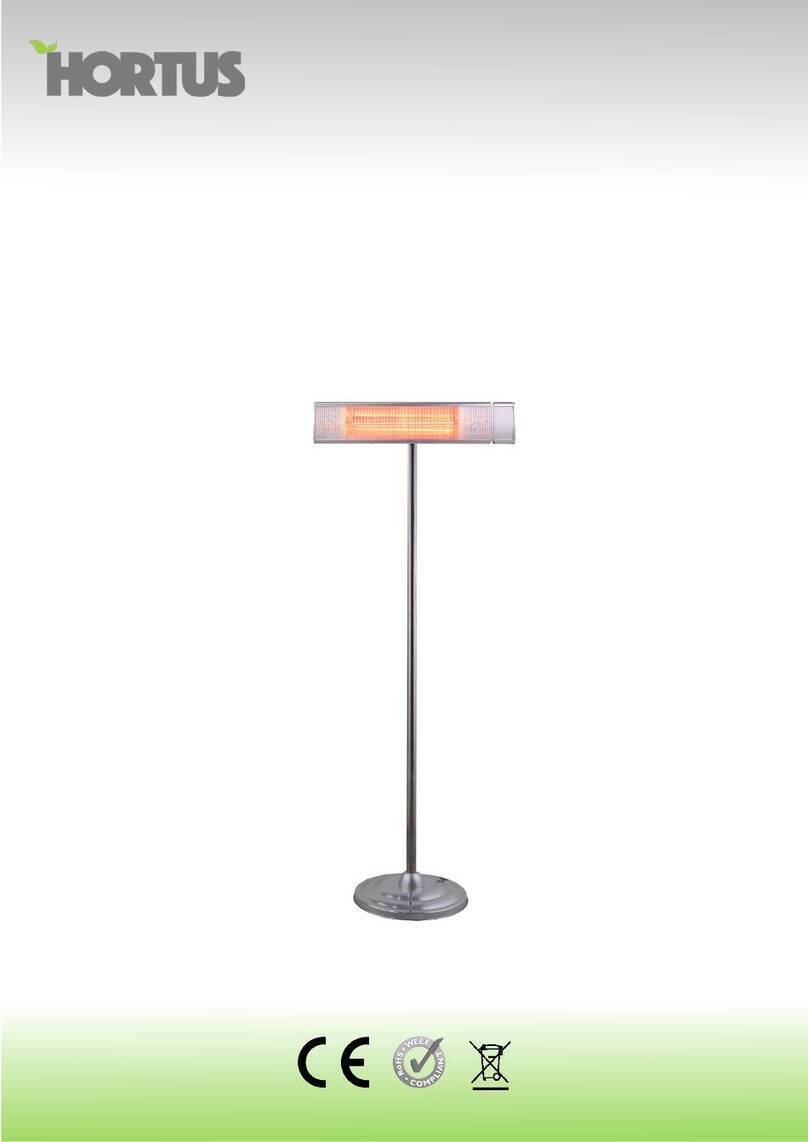
Hortus
Hortus Golden tube THH15 instructions
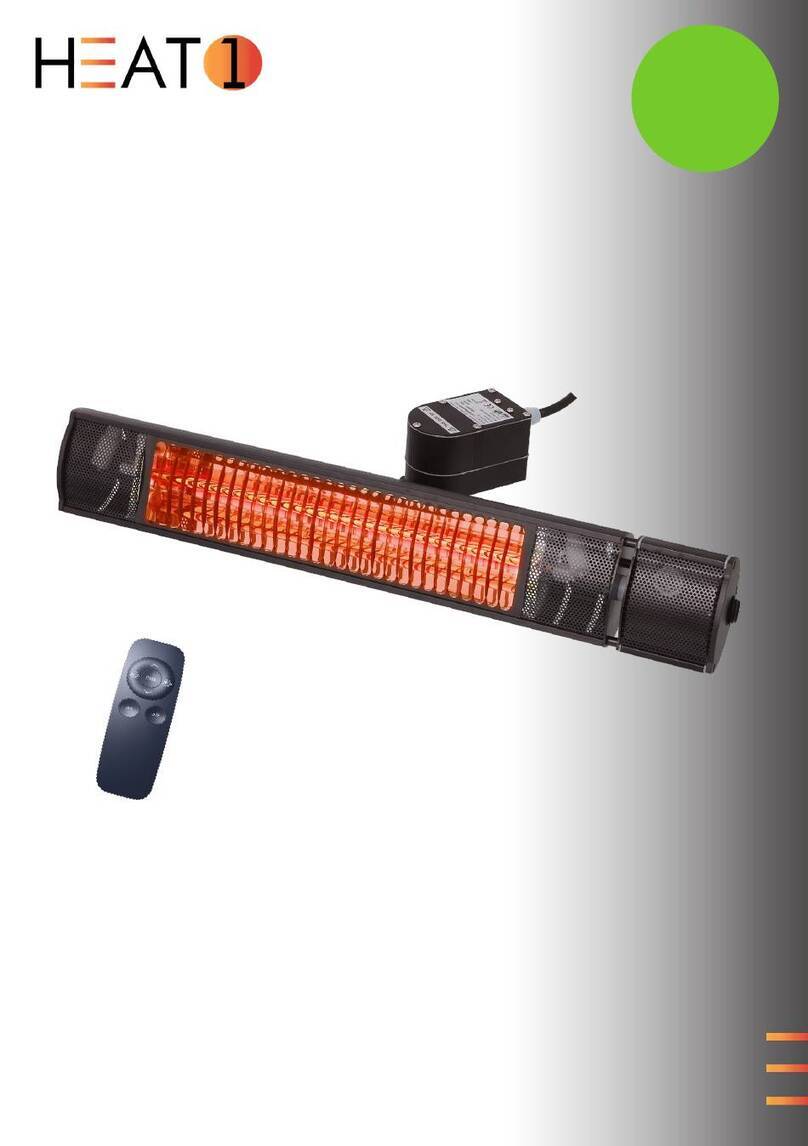
HEAT1
HEAT1 ECO plus-line LDHR005G2-200KY-M instructions
